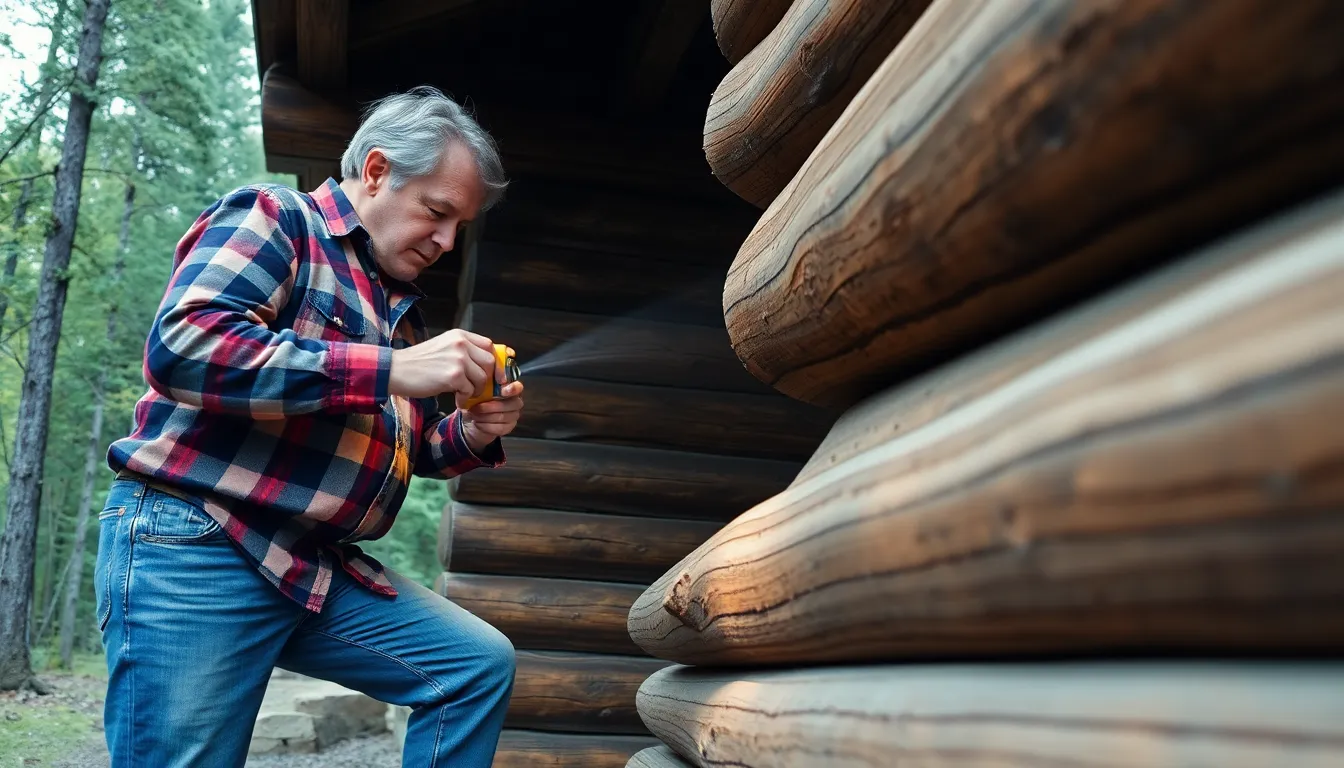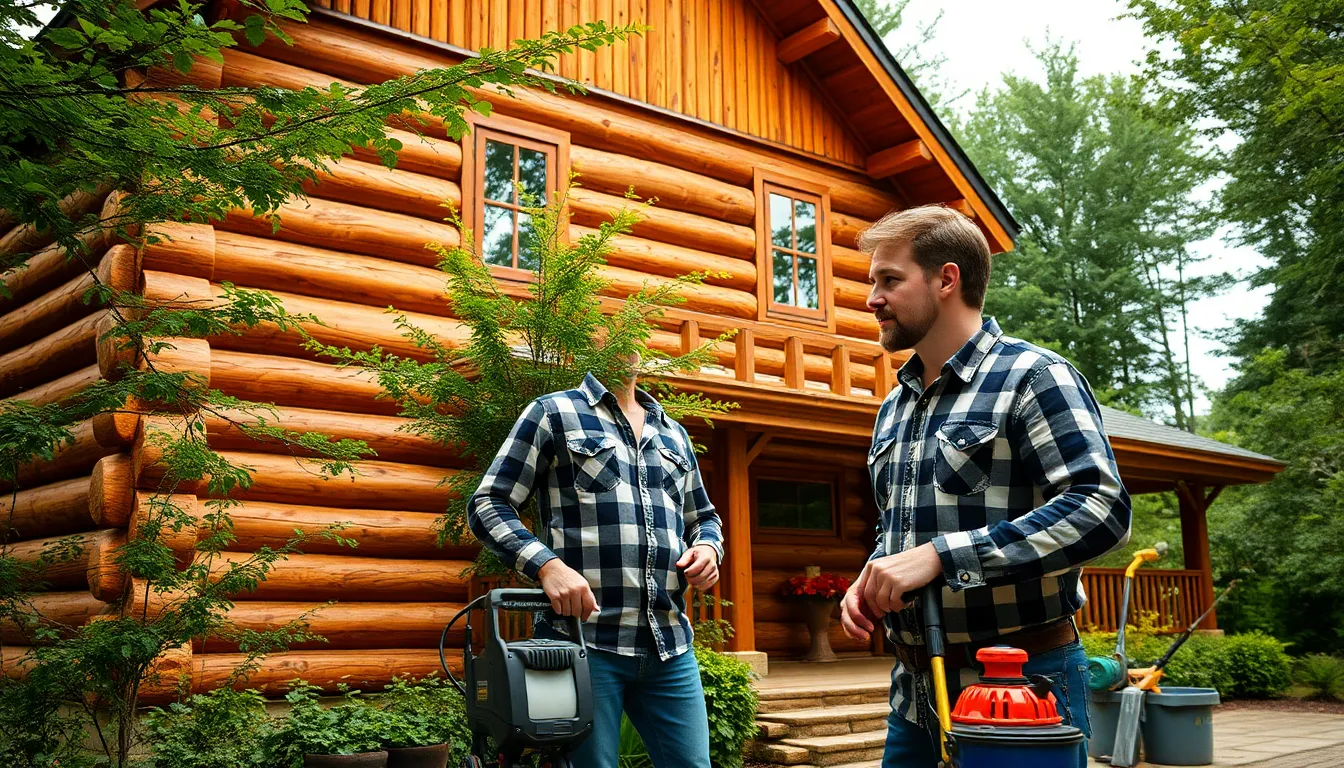Table of Contents
ToggleLog homes have a charm that’s hard to resist. With their rustic appeal and cozy vibes, they’re like a warm hug from nature. But let’s face it: owning a log home isn’t all sunshine and rainbows. It comes with its own set of maintenance challenges that can make even the most seasoned homeowner break into a sweat.
Importance Of Log Home Maintenance
Log home maintenance plays a crucial role in preserving the integrity and beauty of these structures. Regular upkeep prevents issues like rot, insect infestation, and structural degradation, extending the lifespan of the home. Homeowners should inspect the exterior regularly to identify early signs of wear or damage.
Timely maintenance allows for the application of protective sealants that guard against moisture and UV damage. Neglecting these tasks can lead to costly repairs in the future. Furthermore, maintaining the logs helps to enhance the home’s energy efficiency.
Caring for log homes also contributes to indoor air quality. Proper ventilation and upkeep prevent mold and mildew growth, which can affect health and comfort levels. Homeowners are encouraged to clear gutters and downspouts to ensure proper drainage, reducing water accumulation around the foundation.
Keeping up with maintenance tasks not only preserves aesthetics but also maintains property value. Homes that receive regular attention often attract potential buyers who appreciate well-kept log cabins. Additionally, performing maintenance boosts the overall sustainability of the dwelling.
Actively participating in log home maintenance can foster a deeper appreciation for the craftsmanship involved. Homeowners often develop a connection with their property, leading to greater pride in homeownership. Investing effort into maintenance pays off through enhanced longevity and enjoyment of the log home.
Common Maintenance Tasks

Maintaining a log home requires attention to both exterior and interior aspects. Regular upkeep ensures longevity and preserves the home’s natural charm.
Exterior Maintenance
Inspecting the exterior for signs of wear is crucial. Homeowners should check for rot, stains, or gaps in the logs regularly. Cleaning with a gentle solution removes dirt and prevents mold growth. Applying a high-quality sealant every few years protects against moisture and UV damage. Termite inspections annually help prevent infestations from compromising structural integrity. Trimming trees and shrubs keeps them away from the walls, minimizing potential damage.
Interior Maintenance
Maintaining the interior environment impacts overall comfort and health. Air quality can decline if mold and mildew accumulate, so regular cleaning is essential. Homeowners should monitor humidity levels, aiming for a range of 30-50%. Inspecting and replacing insulation prevents energy loss and maintains temperature consistency. Dusting wooden surfaces and using appropriate cleaners preserves the finish and extends the life of logs. Ventilating the space ensures airflow, reducing moisture buildup and enhancing indoor air quality.
Signs You Need Maintenance
Regular inspections help identify maintenance needs in log homes. Homeowners should remain vigilant for key indicators of damage or deterioration.
Warning Signs of Damage
Look for cracks in log walls or around windows. Noticeable gaps signify potential structural issues. Discoloration on logs suggests moisture intrusion or mold growth. Pay attention to insect activity, as wood-boring pests can compromise integrity. Additionally, check for peeling paint or sealant that indicates a need for reapplication. Regularly assessing these signs ensures timely action and preserves the home’s beauty.
Seasonal Issues
Seasonal changes significantly impact log home maintenance. Winter may cause ice dams, leading to water damage if not addressed. Spring brings an increase in humidity, which can foster mold if ventilation is poor. Summer heat can degrade sealants and coatings; reapplication becomes crucial to protect wood. Fall may require gutter cleaning to prevent water buildup. Proactive attention during each season prevents long-term damage and maintains a healthy living environment.
Tools And Products For Maintenance
Maintaining a log home requires specific tools and products to effectively address various tasks. Investing in quality equipment and materials makes maintenance more efficient.
Recommended Tools
Essential tools include a moisture meter, which measures wood moisture content. A pressure washer helps clean surfaces and remove dirt or mildew. A scraper assists in removing old sealants and finishes. Additionally, a screwdriver set allows for easy repair of loose components. A paintbrush is ideal for applying stain or sealant evenly. Homeowners can also benefit from a caulking gun, which fills gaps and prevents moisture intrusion. Each tool contributes to the upkeep of log homes, ensuring longevity and beauty.
Effective Products
Utilize high-performance sealants designed specifically for log homes. These products prevent moisture damage and offer UV protection. A good wood preservative protects against decay and insect infestation, maintaining structural integrity. Stains formulated for outdoor use enhance visual appeal while offering added protection. Cleaning solutions dedicated to log surfaces eliminate mold and dirt without causing harm to the wood. Products containing natural ingredients contribute to better indoor air quality. Incorporating effective products into regular maintenance routines ensures log homes remain vibrant and sturdy.
Best Practices For Log Home Preservation
Regular inspections maintain the integrity of log homes. Homeowners should check for cracks, checks, and discoloration indicating moisture issues or wood decay. Cleaning surfaces prevents mold accumulation and promotes healthy air quality within the home.
Applying high-quality sealants protects against moisture and UV damage. Sealants should be reapplied every three to five years, depending on local climate conditions. Using a moisture meter helps assess wood moisture levels, indicating when maintenance is necessary.
Termite inspections must be conducted at least once a year. Early detection of insect activity prevents significant damage. Additionally, trimming trees and shrubs near the home reduces the risk of damage from falling branches and minimizes moisture retention around the logs.
Regarding interior maintenance, managing humidity levels ensures optimal comfort and health. Regularly checking insulation maintains energy efficiency. Appropriate ventilation systems help control indoor air quality.
Homeowners benefit from using high-performance products designed for log homes. Cleaning solutions specifically formulated for wood help maintain aesthetics without causing damage. Staining wood enhances visual appeal while providing a protective layer against the elements.
Essential tools make log home maintenance more manageable. A pressure washer effectively cleans exterior surfaces, while scrapers and brushes assist in removing debris. Utilizing a caulking gun helps seal gaps, preventing moisture intrusion.
Focusing on these best practices significantly contributes to the long-term preservation of log homes. Consistency in maintenance fosters durability and retains the unique charm of these structures, ensuring a healthy and comfortable living environment.
Maintaining a log home is essential for preserving its unique charm and ensuring a healthy living environment. By staying proactive with regular inspections and upkeep tasks, homeowners can prevent costly repairs and enhance energy efficiency. Utilizing high-quality products and tools tailored for log homes makes maintenance more effective and manageable.
With attention to both interior and exterior needs, owners can enjoy their cozy retreats for years to come. Ultimately, a commitment to diligent care not only safeguards the structure but also enriches the overall experience of living in a log home.





